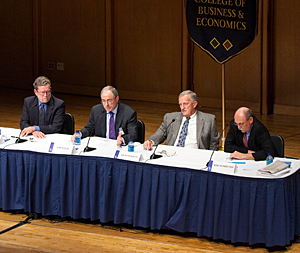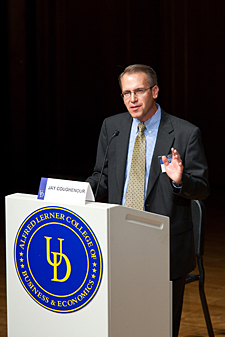- Rozovsky wins prestigious NSF Early Career Award
- UD students meet alumni, experience 'closing bell' at NYSE
- Newark Police seek assistance in identifying suspects in robbery
- Rivlin says bipartisan budget action, stronger budget rules key to reversing debt
- Stink bugs shouldn't pose problem until late summer
- Gao to honor Placido Domingo in Washington performance
- Adopt-A-Highway project keeps Lewes road clean
- WVUD's Radiothon fundraiser runs April 1-10
- W.D. Snodgrass Symposium to honor Pulitzer winner
- New guide helps cancer patients manage symptoms
- UD in the News, March 25, 2011
- For the Record, March 25, 2011
- Public opinion expert discusses world views of U.S. in Global Agenda series
- Congressional delegation, dean laud Center for Community Research and Service program
- Center for Political Communication sets symposium on politics, entertainment
- Students work to raise funds, awareness of domestic violence
- Equestrian team wins regional championship in Western riding
- Markell, Harker stress importance of agriculture to Delaware's economy
- Carol A. Ammon MBA Case Competition winners announced
- Prof presents blood-clotting studies at Gordon Research Conference
- Sexual Assault Awareness Month events, programs announced
- Stay connected with Sea Grant, CEOE e-newsletter
- A message to UD regarding the tragedy in Japan
- More News >>
- March 31-May 14: REP stages Neil Simon's 'The Good Doctor'
- April 2: Newark plans annual 'wine and dine'
- April 5: Expert perspective on U.S. health care
- April 5: Comedian Ace Guillen to visit Scrounge
- April 6, May 4: School of Nursing sponsors research lecture series
- April 6-May 4: Confucius Institute presents Chinese Film Series on Wednesdays
- April 6: IPCC's Pachauri to discuss sustainable development in DENIN Dialogue Series
- April 7: 'WVUDstock' radiothon concert announced
- April 8: English Language Institute presents 'Arts in Translation'
- April 9: Green and Healthy Living Expo planned at The Bob
- April 9: Center for Political Communication to host Onion editor
- April 10: Alumni Easter Egg-stravaganza planned
- April 11: CDS session to focus on visual assistive technologies
- April 12: T.J. Stiles to speak at UDLA annual dinner
- April 15, 16: Annual UD push lawnmower tune-up scheduled
- April 15, 16: Master Players series presents iMusic 4, China Magpie
- April 15, 16: Delaware Symphony, UD chorus to perform Mahler work
- April 18: Former NFL Coach Bill Cowher featured in UD Speaks
- April 21-24: Sesame Street Live brings Elmo and friends to The Bob
- April 30: Save the date for Ag Day 2011 at UD
- April 30: Symposium to consider 'Frontiers at the Chemistry-Biology Interface'
- April 30-May 1: Relay for Life set at Delaware Field House
- May 4: Delaware Membrane Protein Symposium announced
- May 5: Northwestern University's Leon Keer to deliver Kerr lecture
- May 7: Women's volleyball team to host second annual Spring Fling
- Through May 3: SPPA announces speakers for 10th annual lecture series
- Through May 4: Global Agenda sees U.S. through others' eyes; World Bank president to speak
- Through May 4: 'Research on Race, Ethnicity, Culture' topic of series
- Through May 9: Black American Studies announces lecture series
- Through May 11: 'Challenges in Jewish Culture' lecture series announced
- Through May 11: Area Studies research featured in speaker series
- Through June 5: 'Andy Warhol: Behind the Camera' on view in Old College Gallery
- Through July 15: 'Bodyscapes' on view at Mechanical Hall Gallery
- More What's Happening >>
- UD calendar >>
- Middle States evaluation team on campus April 5
- Phipps named HR Liaison of the Quarter
- Senior wins iPad for participating in assessment study
- April 19: Procurement Services schedules information sessions
- UD Bookstore announces spring break hours
- HealthyU Wellness Program encourages employees to 'Step into Spring'
- April 8-29: Faculty roundtable series considers student engagement
- GRE is changing; learn more at April 15 info session
- April 30: UD Evening with Blue Rocks set for employees
- Morris Library to be open 24/7 during final exams
- More Campus FYI >>
Click here to access an audio or video podcast of this event.
5:10 p.m., Sept. 25, 2008----The current financial crisis occurred because no one paid enough attention, and the U.S. Congress could repeat the pattern if it doesn't closely examine the proposed bailout plan, a panel of University of Delaware financial experts said Wednesday evening, Sept. 24. The panel of experts spoke to a packed crowd of approximately 400 in the Loudis Recital Hall of the Amy E. du Pont Music Building.
UD Distinguished Scholar in Residence William Poole told the crowd the hidden inner-workings of companies like AIG and Lehman Brothers are what led to the current crisis, while noting that foreseeing potential pitfalls is difficult even for economists.
“You have to be a real expert in a lot of this stuff to be able to make a judgment,” Poole said. “In fact, any of us up here, with the amount of expertise that we have accumulated over the years, would not be able to look at a published bank balance sheet and tell you whether this bank is sound or not.”
Poole, who recently retired as chief executive of the Federal Reserve Bank of St. Louis, is frequently quoted by the likes of Forbes and Bloomberg News. He joined three current and one former UD professor on stage.
Donald Puglisi, UD professor emeritus of finance and now director of Puglisi & Associates financial advisers, outlined the root causes of the crisis. They include, Puglisi said, irresponsible borrowers; consumers' financial illiteracy; government tax incentives for homebuyers; Freddie Mac and Fannie Mae's lending practices; former Federal Reserve Chairman Alan Greenspan; banking regulators and credit rating agencies.
Puglisi said the $700 billion Troubled Asset Relief Program proposed by the Bush administration is not a solution to these problems. “At most it is a stopgap measure to the current crisis,” he said.
Poole said the $700 billion bailout plan is not detailed enough. Noting that the Department of Treasury presented the entire plan to Congress in a document less than three pages long, Poole said it gives the Treasury too much power with too little oversight.
“We need to be sure we are not going to make things worse, which is what I believe is going to happen,” Poole said.
Puglisi argued any plan passed by Congress needs to be guided by two principles.
“The Treasury plan,” Puglisi said, “must not reward failure, and I think it should also be designed to minimize the cost to the American taxpayer.”
The panelists told the audience they did not have a fully formed solution to Wall Street's problems.
“There's no playbook for this. There's no plan,” said James Butkiewicz, professor of economics.
He and his colleagues noted any reform should include more oversight.
“I think it is important to convince people that the game is fair,” Butkiewicz said. It also involves convincing the public banking is safe, he noted.
The panel's experts called the situation a crisis, but agreed consumers can be confident their money is secure in a traditional commercial bank. They said educating consumers about the basics of banking could help boost confidence levels.
“There are many, many different kinds of financial institutions out there that the word 'bank' is involved with: commercial banks, investment banks, mortgage banks,” said Robert Schweitzer, Donald J. Puglisi Professor of Finance and professor of economics.
Schweitzer said mortgage bankers deserve a considerable amount of blame for the crisis. “Your typical commercial bank, which takes deposits [and] makes loans is not,” he said, part of the problem.
Article by Andrea Boyle
Photos by Kevin Quinlan





